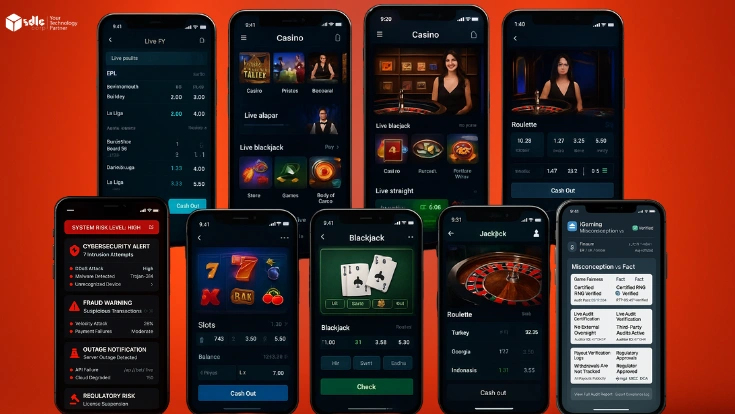Introduction
In the competitive world of online gaming, especially within the realm of casino game development, ensuring uninterrupted gameplay is crucial. Players expect a seamless experience, and any downtime or glitches can lead to frustration, loss of players, and revenue. This is where fault tolerance comes into play. By architecting fault-tolerant systems, casino game development companies can ensure that their games remain available and reliable, even in the face of hardware failures, software bugs, or network issues. This article explores strategies for achieving fault tolerance in casino game architecture, providing valuable insights for game development services.
Transform Your Gaming Experience Today!
A Casino Game Development Company specializes in creating immersive and engaging casino games for online and offline platforms.

Understanding Fault Tolerance
Fault tolerance refers to the ability of a system to continue functioning correctly even when some of its components fail. In the context of casino games, this means that the game should remain operational and responsive, even if a server goes down, a database connection is lost, or a piece of critical infrastructure fails.
Key Components of Fault-Tolerant Systems:
- Redundancy: Duplication of critical components to ensure that a failure in one does not bring down the entire system.
- Failover Mechanisms: Automated processes that switch operations to a standby system when a failure occurs.
- Load Balancing: Distributing traffic across multiple servers to prevent any single server from becoming a point of failure.
Strategies for Achieving Fault Tolerance in Casino Games
To build a fault-tolerant casino game architecture, casino game development services must implement several key strategies:
1. Implementing Redundancy at Every Level:
Redundancy is the cornerstone of fault tolerance. By duplicating critical components, such as servers, databases, and network connections, you can ensure that the system can continue operating even if one component fails.
Example: A casino game development company might deploy multiple instances of its game servers across different geographic locations. If one server fails, players are automatically redirected to another server, ensuring uninterrupted gameplay.
2. Utilizing Distributed Databases:
Distributed databases, such as Apache Cassandra or Google Cloud Spanner, allow data to be stored across multiple nodes, ensuring that data remains available even if one node fails. This approach not only enhances fault tolerance but also improves data access speed by allowing queries to be processed closer to where the data is stored.
3. Leveraging Load Balancing:
Load balancers distribute incoming traffic across multiple servers, preventing any single server from becoming a point of failure. In the event of a server failure, the load balancer automatically redirects traffic to other available servers, maintaining the continuity of the game.
Example: Using a service like AWS Elastic Load Balancing (ELB) allows a casino game development agency to balance traffic across multiple instances, ensuring that no single point of failure can disrupt the gaming experience.
4. Employing Microservices Architecture:
Microservices architecture involves breaking down the game into smaller, independent services that can be deployed, scaled, and managed separately. This approach enhances fault tolerance by isolating failures to individual services, preventing them from affecting the entire system.
Example: A game development company might separate user authentication, payment processing, and game logic into different microservices. If the payment service fails, players can still access the game, and only the payment process is affected.
5. Implementing Real-Time Monitoring and Alerts:
Real-time monitoring tools, such as Prometheus and Grafana, allow developers to track the performance and health of the system continuously. By setting up alerts for critical thresholds, teams can respond quickly to potential issues before they escalate into major problems.
6. Utilizing Automated Failover and Recovery:
Automated failover mechanisms detect failures and automatically switch to backup systems without human intervention. Coupled with automated recovery processes, this ensures that the system can return to full functionality quickly after a failure.
Example: Microsoft Azure Site Recovery is a disaster recovery service that automates the failover process, ensuring that applications remain available even during outages.
Optimize casino servers with expert developers!
Hiring skilled casino game developers is crucial for creating engaging and successful gaming experiences.

Challenges in Implementing Fault Tolerance
While fault tolerance is essential, it comes with challenges that casino game development services must address:
1. Increased Complexity:
Implementing fault tolerance requires careful planning and the integration of multiple redundant systems, which can increase the overall complexity of the architecture. This complexity must be managed to avoid introducing new points of failure.
2. Higher Costs:
Redundancy, load balancing, and automated failover mechanisms often require additional infrastructure and resources, leading to higher operational costs. Companies must balance the need for fault tolerance with budget constraints.
3. Ensuring Data Consistency:
In distributed systems, ensuring data consistency across multiple nodes can be challenging. Techniques such as eventual consistency or strong consistency models must be carefully selected based on the specific requirements of the game.
Future Trends in Fault Tolerance for Casino Games
As technology evolves, new trends are emerging that will further enhance fault tolerance in casino game architecture:
1. AI-Driven Fault Detection:
Artificial intelligence (AI) can be used to predict and detect faults before they occur, allowing for proactive measures to be taken. AI-driven systems can analyze patterns and trends to identify potential failures and optimize the response.
2. Serverless Architectures:
Serverless computing, such as AWS Lambda, automatically scales and manages the underlying infrastructure, reducing the risk of server failures. By abstracting the infrastructure layer, serverless architectures inherently provide a level of fault tolerance.
3. Blockchain for Data Integrity:
Blockchain technology can be used to ensure the integrity and immutability of critical game data. By storing data on a decentralized ledger, blockchain reduces the risk of data tampering and loss, enhancing fault tolerance in the game’s backend systems.
Unlock Expert Game Development Services Today!
Game development services offer end-to-end solutions for creating engaging, high-quality games across platforms.

Conclusion
Achieving fault tolerance in casino game architecture is essential for providing a reliable and seamless gaming experience. By implementing strategies such as redundancy, distributed databases, load balancing, and microservices, casino game development companies can ensure that their games remain available and responsive, even in the face of unexpected failures.
As the gaming industry continues to grow and evolve, staying ahead of potential issues with proactive fault tolerance measures will be crucial for maintaining player trust and ensuring the long-term success of your games.

















